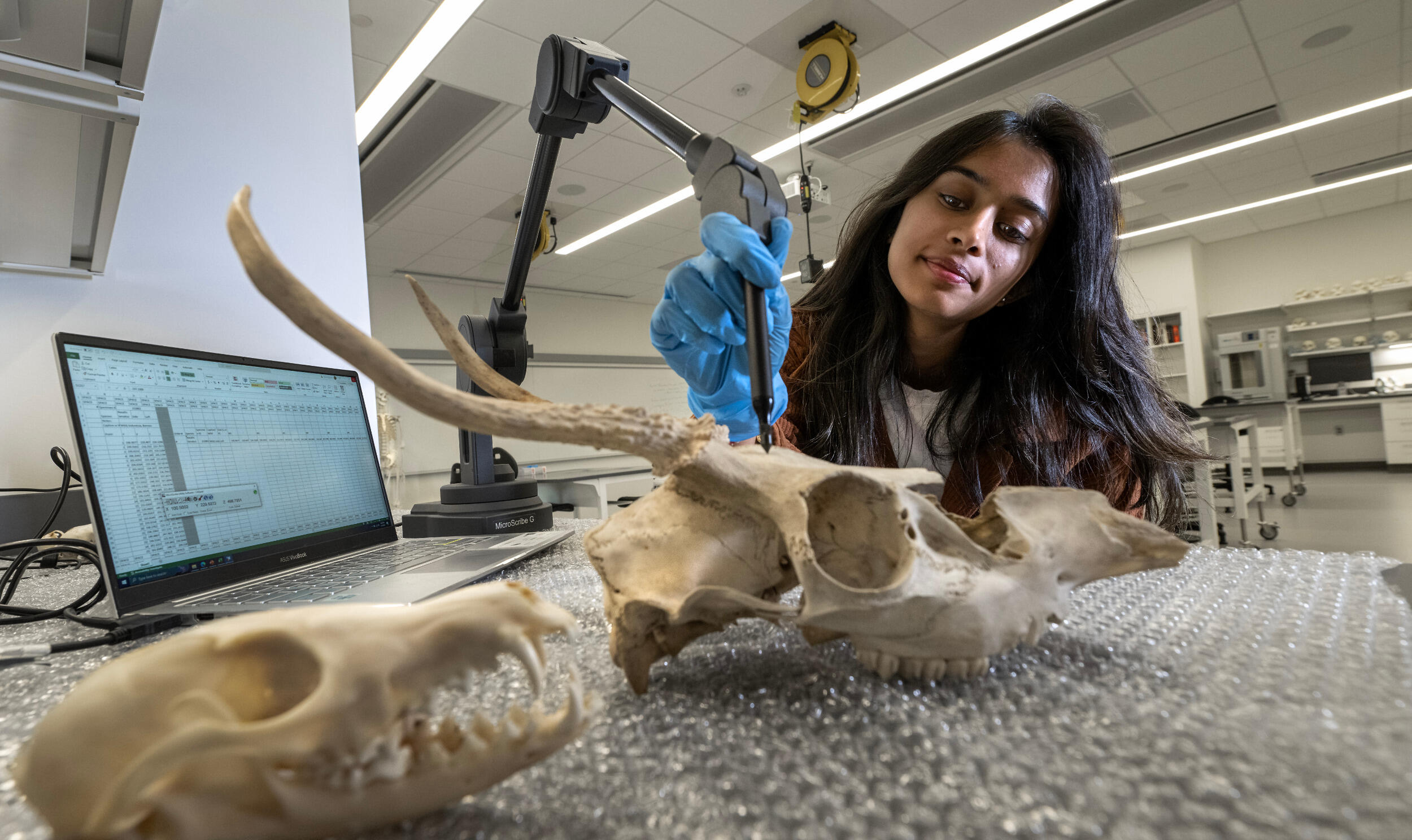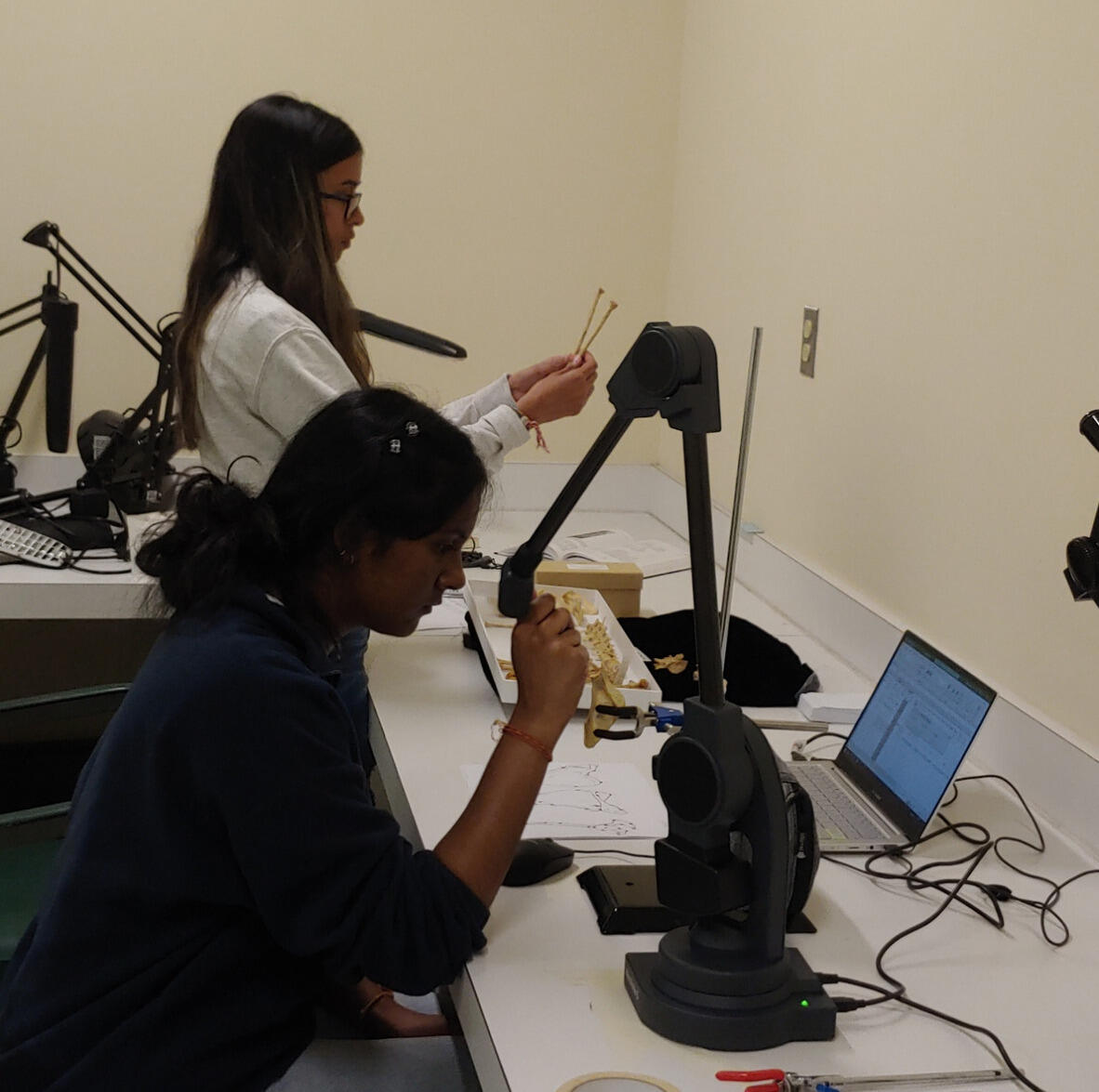
April 12, 2024
Charmi Patel goes bone-deep behind the scenes at the Smithsonian Museum of Natural History
VCU sophomore studies skeletons of nonhuman primates for clues into death and disease.
Share this story
About Every Ram’s a Researcher: As part of Research Weeks 2024, this series highlights the ways that undergrads at VCU, no matter their major, get involved with meaningful research that enriches their college experience.
Charmi Patel’s interest in studying bone pathology in nonhuman primates was inspired by the disease trends, prevention and control class she took in her freshman year at Virginia Commonwealth University.
Last summer, Patel, now a sophomore who is majoring in health, physical education and exercise science with a concentration in health science, traveled to Washington, D.C., on two occasions to research primate bones at the Smithsonian Museum of Natural History with funding from VCU’s Undergraduate Research Opportunities Program. She believes pathological changes in the nonhuman skeletons, such as fractures and osteoarthritis, can offer insight into past behaviors and environmental stressors.
“Studying primate skeletons can reveal their behavior, ecology and evolution,” Patel said. “However, little research has been done on pathology in nonhuman primate museum collections.”
Results from the collection she studied showed that Cercopithecinae monkeys in captivity more likely died of natural or aging-related causes and were less likely to get injured since there were fewer stressful factors (such as predators or group aggression).
“Colobine monkeys were all captured in the wild by naturalists who likely trapped and shot the specimens, evident in fractures. The same was observed in the apes, in terms of fractures or broken bones from human intervention rather than natural deaths,” Patel said. “As for bone disease, 20% of the total sample has arthritis, bone disease, fused spine and bone growth, which means that as primates age, they are more susceptible to osteological-related diseases.”

She said these findings “should be included in the databases of museum collections in order to advance understanding and research.”
Patel was “wonderful to work with,” said Marie Vergamini, a doctoral student in VCU’s Center for Integrative Life Sciences Education who served as Patel’s research professor and is part of the Rector Paleoecology Lab. “She had to learn medical knowledge at the ready. When we went to collect data, she was very diligent in inspecting every bone in the collection.”
Patel answered some quick additional questions about her experience as an undergraduate researcher.
What led you to this research?
I took a disease class my freshman year of college, and that’s what inspired me to do my research in osteological pathology in nonhuman primates. Although there may be some differences between monkey and human bones, the majority of our bones are very similar. It also brought up the questions, “What variation of death affects bone pathology in nonhuman primates?” and “What is the overall percentage of bone disease and fractures in bone pathology of these nonhuman primates?”
Beyond the research itself, what skills or connections have you developed through this project?
I gained multiple skills, such as time management, communication skills and analytical skills, which will assist me in the rest of my time at VCU as well as throughout my journey after graduation. I made a great connection with my Ph.D. research professor, Marie Vergamini, and I have learned many valuable skills from her that have and will assist me in growing personally and professionally.
What did you enjoy the most about this project?
The research project was enjoyable to me because it involved both student and professor collaboration, and topic inquiry and discovery. The sharing of thoughts and viewpoints promoted a spirit of unity and assistance among one another. The initiative also emphasized the significance of participating in talks with other scholars, encouraging significant contributions to the field and presenting discoveries.
What advice do you have for other undergrads on how to get involved in research?
My advice is to examine your interests. Give your academic passions and interests some thought. If you believe that your major doesn’t usually entail research, don’t be disheartened, because there are research opportunities in almost every discipline.
Think about how you can use research techniques on subjects that you are interested in. Make contact with faculty members who are conducting research in fields that interest you, either in your department or in departments that are related to them. Inform them of your desire to participate in research, and inquire about undergraduate student opportunities.
Subscribe to VCU News
Subscribe to VCU News at newsletter.vcu.edu and receive a selection of stories, videos, photos, news clips and event listings in your inbox.













